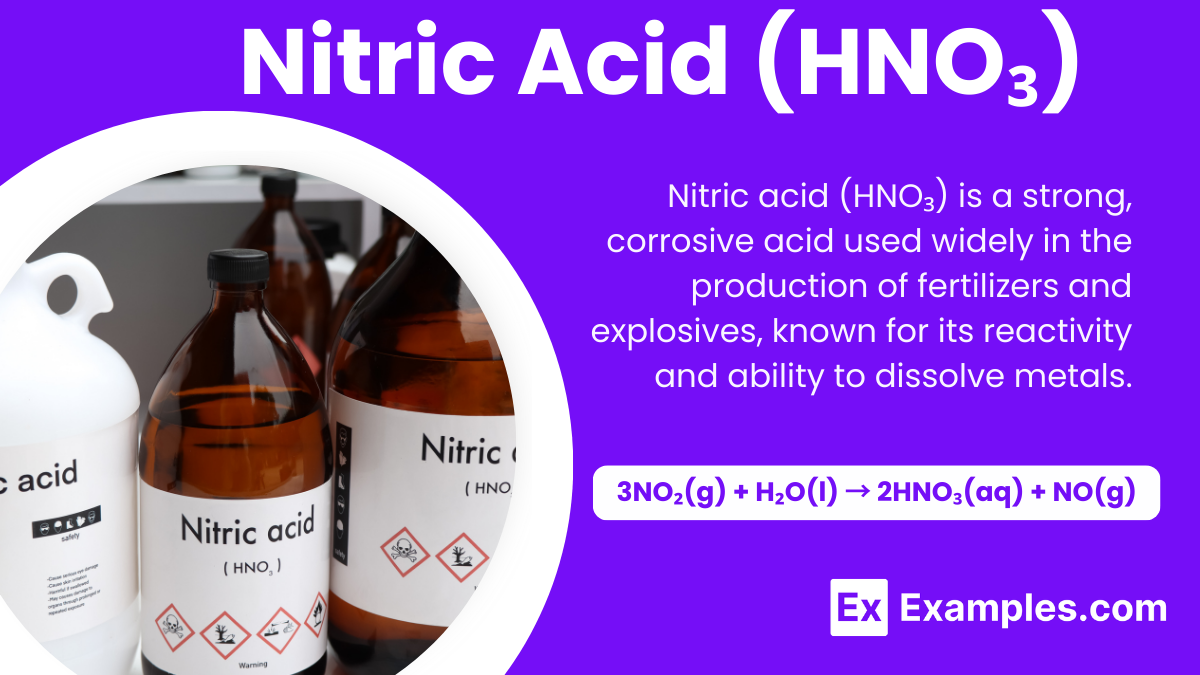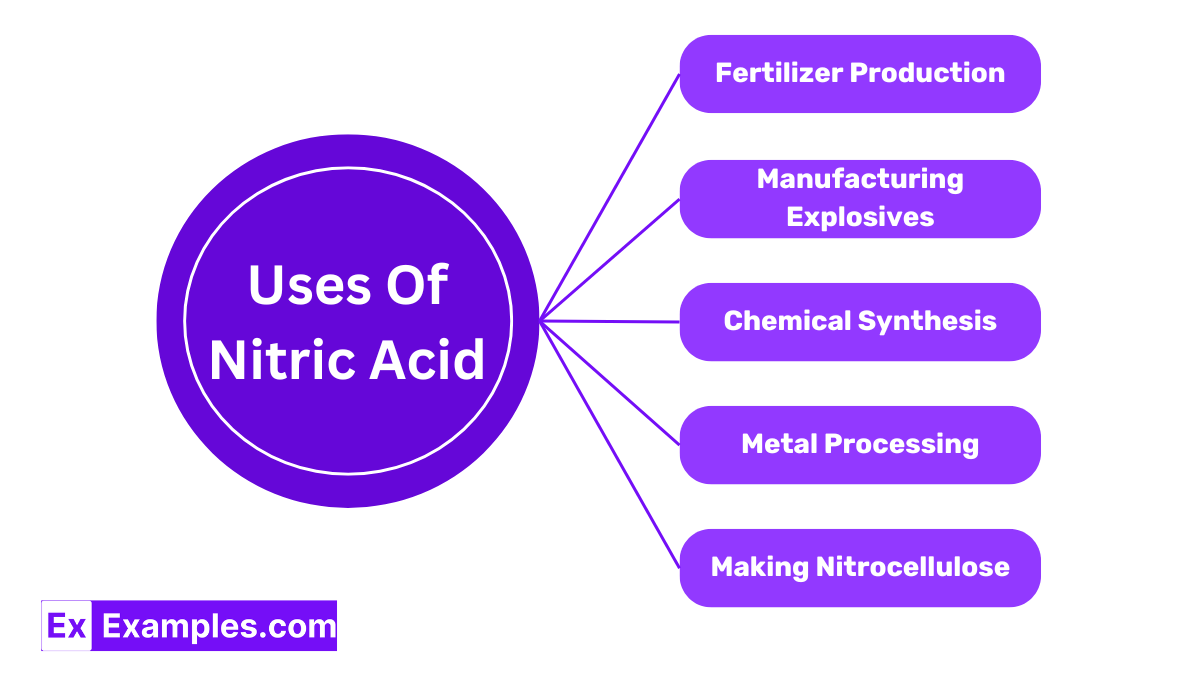What is the chemical formula of nitric acid?
HCl
H₂SO₄
HNO₃
H₃PO₄


Nitric acid is a powerful and fascinating substance in the world of chemistry. Known for its sharp, pungent smell and its ability to react with metals. This acid plays a crucial role in various scientific and industrial processes. It’s a liquid that’s not only important for making fertilizers but also in manufacturing explosives and plastics. When you think about acids, nitric acid stands out because of its versatility and the interesting reactions it undergoes.
| Property | Value |
|---|---|
| Formula | HNO₃ |
| Name | Nitric acid |
| Alternate Names | Anhydrous nitric acid, Azotic acid, Hydrogen nitrate, Nital, Spirit of nitre |

Nitric acid, a key player in both the natural world and industry, has a simple yet fascinating molecular structure. At its core, nitric acid is composed of one nitrogen atom, which acts as the central figure, connected to three oxygen atoms. One of these oxygen atoms forms a double bond with nitrogen, showcasing a strong link, while another oxygen is attached through a single bond but also holds onto an additional hydrogen atom. This unique setup gives nitric acid its acidic properties, allowing it to donate a proton (the hydrogen atom) in chemical reactions. This structure not only explains why nitric acid behaves as a strong acid but also highlights its role in creating nitrates, vital for plant growth and various industrial processes.
Nitric acid is produced using a method known as the Ostwald process, which involves a few steps and key ingredients: ammonia, oxygen, and water. First, ammonia gas is combined with oxygen gas in the presence of a catalyst, a substance that speeds up the reaction without being consumed by it. This reaction produces nitrogen dioxide (NO2), a reddish-brown gas, and water. The chemical equation for this step is:
In the next step, the nitrogen dioxide reacts with more oxygen and water to finally form nitric acid. This reaction can be represented by the chemical equation
Through these reactions, ammonia, a compound that can be produced in large quantities, is transformed into nitric acid, a vital chemical for various industries, including the production of fertilizers and explosives. This process showcases the fascinating transformation of simple molecules into a powerful acid.
| Property | Description |
|---|---|
| Appearance | Nitric acid is a colorless liquid, but it can turn yellow or even red-brown upon prolonged exposure to light or heat, due to the decomposition into nitrogen oxides and water. |
| Chemical Formula | The chemical formula for nitric acid is HNO₃. |
| Density | Nitric acid has a density of approximately 1.51 g/cm³, making it heavier than water. |
| Boiling Point | It boils at about83°C (181°F), which is relatively low compared to other acids, indicating its high volatility. |
| Solubility | It is highly soluble in water, capable of forming a variety of concentrations, often used in different industrial and chemical processes. |
| Reactivity | Nitric acid is highly reactive, particularly with metals, excluding gold and platinum, and forms nitrates, which are integral in many chemical syntheses and applications. |
| Property | Value |
|---|---|
| CAS registry number | 7697-37-2 |
| PubChem compound ID | 944 |
| PubChem substance ID | 24853516 |
| SMILES identifier | N+(O)[O-] |
| InChI identifier | InChI=1/HNO3/c2-1(3)4/h(H,2,3,4)/f/h2H |
| MDL number | MFCD00011349 |
| Property | Value |
|---|---|
| NFPA health rating | 3 |
| NFPA fire rating | 0 |
| NFPA reactivity rating | 1 |
| NFPA hazards | Oxidizing agent |

One of the primary uses of nitric acid is in the production of ammonium nitrate, a compound widely used in fertilizers. This helps plants grow faster by providing them with essential nitrogen.
Nitric acid is also crucial in the manufacture of explosives. It reacts with organic compounds to form nitro compounds like nitroglycerin and TNT, which are essential in mining and construction.
In the chemical industry, nitric acid is used to produce various chemicals, especially those that contain nitrogen. It serves as a starting material for producing plastics, dyes, and pharmaceuticals.
Nitric acid plays a role in the purification and etching of metals. It is used to clean metal surfaces before painting or soldering and can also etch designs into metal for jewelry and electronics.
Another interesting application of nitric acid is in the production of nitrocellulose, which is used in lacquers and early photographic films. Nitrocellulose is created by reacting cellulose with nitric acid, resulting in a substance that forms a durable and clear film.
In laboratories, nitric acid is commonly used as a reagent in chemical analyses. It helps identify the presence of certain substances by producing distinctive color changes or reactions.
Nitric acid is a strong acid because it completely dissociates into hydrogen ions and nitrate ions in water, enhancing its reactivity.
Nitric acid can cause severe burns, respiratory distress, and damage to the eyes upon contact or inhalation due to its corrosive nature.
Yes, coffee can increase nitric oxide levels in the body, improving blood flow and vascular function due to its antioxidant content.
In moderation, nitric oxide is beneficial and helps regulate blood flow. However, excessive levels can contribute to kidney damage and disease.
Text prompt
Add Tone
10 Examples of Public speaking
20 Examples of Gas lighting
What is the chemical formula of nitric acid?
HCl
H₂SO₄
HNO₃
H₃PO₄
Nitric acid is commonly used in the production of:
Plastics
Fertilizers
Glass
Textiles
What is the oxidation state of nitrogen in nitric acid?
-3
0
+3
+5
Which property describes nitric acid?
Weak acid
Strong acid
Neutral
Weak base
Nitric acid reacts with metals to produce:
Metal oxides
Metal nitrates
Metal sulfates
Metal phosphates
What is the common industrial method for producing nitric acid?
Haber process
Ostwald process
Contact process
Solvay process
What color does concentrated nitric acid turn on standing?
Blue
Green
Yellow
Red
Nitric acid is a component of which common laboratory reagent?
Aqua regia
Benedict's solution
Fehling's solution
Tollen's reagent
What safety precaution is essential when handling nitric acid?
Wear rubber gloves
Use in a well-ventilated area
Store in a wooden container
Use plastic utensils
The pH of a 1 M solution of nitric acid is approximately:
0
1
2
3
Before you leave, take our quick quiz to enhance your learning!

